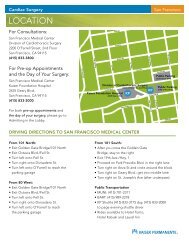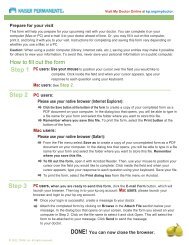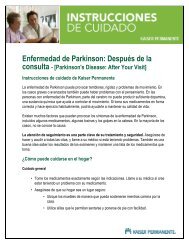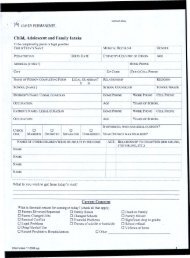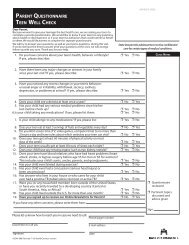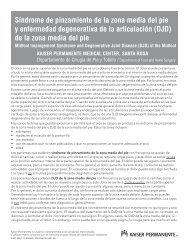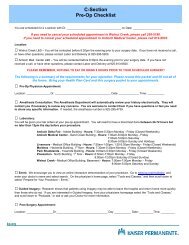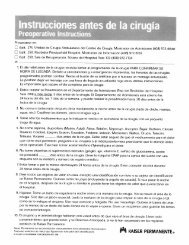Female Recurrent Urinary Tract Infection - My Doctor Online The ...
Female Recurrent Urinary Tract Infection - My Doctor Online The ...
Female Recurrent Urinary Tract Infection - My Doctor Online The ...
Create successful ePaper yourself
Turn your PDF publications into a flip-book with our unique Google optimized e-Paper software.
<strong>Female</strong><br />
Kaiser Oakland Urology
First Some Basics<br />
“UTI”means urinary tract infection<br />
UTIs are almost ALWAYs caused by one bacteria<br />
species growing in the bladder<br />
“Cystitis" means bladder inflammation<br />
Usually from a bladder infection
Bladder <strong>Infection</strong><br />
Most UTIs are really bladder infections<br />
Typical Bladder UTI symptoms:<br />
Frequent and urgent urination<br />
Burning or discomfort during urination<br />
Pressure over the bladder<br />
Blood in urination
<strong>Female</strong> Anatomy<br />
<strong>The</strong> Big Picture
<strong>Female</strong> Anatomy<br />
Near the bladder
How is a UTI diagnosed?<br />
Urinalysis (“UA”):<br />
Preliminary test – same day results<br />
Based on properly collected “midstream”<br />
urine specimen<br />
UTI preliminary diagnosis made on basis of:<br />
White blood cells (wbcs)<br />
a sign of inflammation
UA False Positive Tests
Urine Culture<br />
Confirms the UA result<br />
Takes 24‐48 hrs for results<br />
Added Information<br />
Bacteria type<br />
Bacterial antibiotic sensitivities<br />
Expected response to particular antibiotics<br />
Many bacteria are resistant to common<br />
antibiotics
Urine Culture<br />
False Positives<br />
Common Problem!<br />
Many women have great difficulty collecting a<br />
clean catch urine specimen due to their<br />
anatomy<br />
Poor collection technique<br />
Vaginal skin bacteria contaminate the urine<br />
specimen<br />
Many urine cultures result in indeterminate<br />
“mixed genital flora” culture results
<strong>The</strong> Typical TRUE UTI test<br />
Results<br />
UA:<br />
10‐25 wbc<br />
Rare epithelial cell<br />
Urine Culture:<br />
E. Coli Bacteria<br />
50,000‐100, 000 CFU
<strong>The</strong> Typical False Positive UTI<br />
test Results<br />
UA:<br />
0‐5 wbc<br />
Many epithelial cells<br />
implies poor collection<br />
Urine Culture:<br />
Mixed Genital Flora ( lots of different bacteria)<br />
10,000‐25, 000 CFU
Potential result of<br />
Indeterminate Urine tests<br />
Uncertainty about the diagnosis<br />
Other conditions may be the cause of UTI‐<br />
like symptoms or abnormal urine tests!<br />
Unnecessary use of antibiotics<br />
Treatments with ineffective antibiotics<br />
Side‐effects of antibiotics<br />
Acquiring resistant bacteria
Getting to the Right Diagnosis<br />
Indeterminate urine tests are a fact of life!<br />
Most indeterminate urine tests result from collection<br />
problems
Solving the Problem<br />
Straight Catheterization<br />
Sterile collection<br />
Reliable results<br />
Takes 2 minutes<br />
Minimal or no pain
Straight Catheterized Urine<br />
Tests<br />
Correctly identifies real UTIs<br />
Selection of the best antibiotic<br />
Sometimes suggest possible cause<br />
Identifies patients who do not have UTIs!<br />
<strong>The</strong>se patients are often VERY frustrated<br />
Continued symptoms<br />
Multiple treatments with unhelpful antibiotics<br />
Leads to appropriate treatment of the their<br />
true problem
UTI Bacteria<br />
Bacteria live on and in our bodies<br />
Very clean people still have bacteria!<br />
Common location for lots of bacteria:<br />
Genital and anal areas<br />
Colon<br />
Mouth<br />
Hands
Bacteria that cause UTIs<br />
Come from ourselves –not others!<br />
Sources of bacteria:<br />
Our colon –the ultimate reservoir!<br />
Our anal area<br />
Our genital areas<br />
UTIs result when these bacteria:<br />
Enter our bladders through the urethra<br />
Survive our defense mechanisms<br />
Grow and thrive
Antibiotics Resistance<br />
Repeated use of antibiotics can leads to bacterial<br />
resistance.<br />
Women don’t become resistant, their bacteria do!
Antibiotics Resistance<br />
When bacteria in the vagina and colon are repeatedly<br />
exposed to antibiotics, resistant bacteria are selected<br />
and promoted.<br />
Survival of the fittest!<br />
Resistant bacteria survive, sensitive bacteria don’t!
Antibiotics Resistance is<br />
Dangerous<br />
Antibiotic resistant bacteria:<br />
May not respond to standard treatments when we are<br />
seriously ill from infection!<br />
Colonize our skin, nose, mouth, colon, genital areas and<br />
homes<br />
<strong>The</strong>y create a potential danger to people we live with too.
Our Plan to Prevent<br />
Antibiotic Resistance<br />
Use antibiotics only when we really need them.<br />
Use the right antibiotic that kills the specific bacteria<br />
involved in infection.<br />
Use the shortest course necessary.<br />
Avoid the use of multiple antibiotics.<br />
Use good hygiene to prevent spreading resistant<br />
bacteria<br />
Hand washing!
Why Do Some Women Get Lots<br />
of UTIs?<br />
Failure of defense mechanisms
Defense Against UTIs<br />
Urethra “door way”<br />
Length<br />
Men have longer urethra’s<br />
<strong>The</strong>y have fewer UTIs<br />
Closure<br />
An open urethra lets bacteria in<br />
Immune system<br />
Mechanical flushing during urination<br />
Complete bladder emptying<br />
Frequent bladder emptying
What is the most common cause of<br />
UTIs for Healthy Women?<br />
It is in the genes!
Genetic Susceptibility<br />
Our genes determine which proteins line our urinary<br />
tract<br />
Certain proteins on our urinary tract act as “handles”<br />
for bacterial adherence<br />
Adherence proteins allow bacteria to avoid the usual<br />
mechanical washing defenses that are important for<br />
resistance to infection
Other common causes of UTIs<br />
Poor bladder emptying<br />
Stagnant urine promotes bacteria growth<br />
Impaired immune system<br />
Diabetes<br />
Steroids ( Prednisone)<br />
Immune suppression medications<br />
Impaired urethral gate‐keeper mechanisms
Causes of poor bladder<br />
emptying<br />
Neuropathy<br />
Diabetes<br />
Parkinson’s<br />
M.S.<br />
Poor bladder contractility<br />
Common among elderly women<br />
Chronic bladder over‐distension<br />
Urine holding<br />
Teachers!<br />
Poor bladder habits
Common causes of Poor<br />
Bladder emptying<br />
Dysfunctional voiding<br />
Pelvic floor dysfunction<br />
Anxiety and stress!!!<br />
Cystocoele/ Pessaries<br />
Unknown causes
Poor Urethra Gate‐keeper<br />
Shortened Urethral length<br />
Anatomic changes w/ aging<br />
Shortens the functional urethra length<br />
Poor Urethral closure<br />
Stress incontinence<br />
Post Menopause<br />
Poor Hygiene<br />
Foreign body<br />
Pessary<br />
Catheters<br />
<strong>Urinary</strong> incontinence<br />
chronic wetness
Rare Causes of UTIs<br />
<strong>Infection</strong> kidney stones<br />
Specific bacteria form stone<br />
Routine calcium stones due not harbor bacteria!<br />
Urethral Diverticula<br />
Colovesical fistula<br />
Connection between bladder and colon<br />
Vesico‐vaginal fistula<br />
Connection between bladder and vagina<br />
Radiation, GYN cancers
Signs that Serious Causes<br />
of UTIs May Be Present<br />
Fever >101 degrees<br />
Visible blood in urine despite appropriate<br />
antibiotic treatment<br />
Childhood UTIs or congenital urinary tract<br />
problems<br />
Passing air during voiding<br />
Chronic bladder issues when UTI is NOT present<br />
Unexplained weight loss<br />
Unexplained chronic illness
When Women are MOST susceptible<br />
Sexual activity‐<br />
Bacteria enter the bladder<br />
VERY common for young women<br />
“Honeymoon cystitis”<br />
Women 18‐30<br />
After menopause
Practical Solutions<br />
Prevention!<br />
Suppressive antibiotics<br />
Short course of “as needed” antibiotics
UTI Prevention<br />
Reduce risk factors<br />
Improve bladder emptying<br />
Increase fluid intake<br />
2L daily<br />
Frequent voiding<br />
Timed every 2 hrs during the day<br />
Void immediately after sexual activity<br />
Manage incontinence<br />
Manage stress and anxiety
Suppressive Antibiotics<br />
Level the playing field!<br />
Many risk factors can’t be changed.<br />
Genetic susceptibility<br />
Makes sense if 6+ UTIs every year<br />
<strong>The</strong>se women likely have genetic<br />
susceptibility!<br />
Suppressive Treatment:<br />
Minimize the development of antibiotic<br />
resistant bacteria<br />
Small antibiotic dose ( urinary cleansing)<br />
After or before sex<br />
Daily or every other day
As Needed Antibiotics<br />
For women with a few UTIs every year<br />
Treat when symptoms arise<br />
Suppressive treatment is over exposure to<br />
antibiotics<br />
As Needed Treatment:<br />
Refillable, open prescriptions<br />
3‐5 day antibiotic treatment<br />
Urine tests should be performed before starting<br />
Confirm UTI is present<br />
Confirm antibiotic will be effective<br />
Lab slips ready at home
Need More Information?<br />
American Urological Association<br />
www.urologyhealth.org/<br />
National Institute of Health<br />
www.kidney.niddk.nih.gov/<br />
Your Kaiser Urologist’s Website



